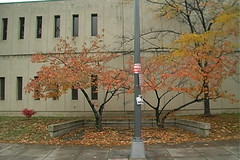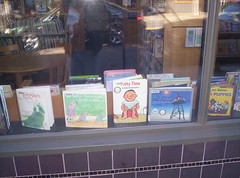Citizen's Summit and libraries
This started as a response to an email about the state of maintaining DC's historic record, issues relating to the DC Archives, etc. It's been expanded in this entry.
During the Citizen's Summit this weekend I was disappointed with the session on libraries. Dorothy Brizill, writing in themail, in an entry entitled "Boards and Commissions Developments" beat me to the punch in writing about the "blue ribbon Library commission" and their suggestions. My summing up of this commission, mostly of "experts" who probably don't even use libraries very much (exception Vartan Gregorian), based on what was presented at the Citizens Summit, is 7 words -- "Is this the best you can do?"
Here's part of what Dorothy wrote: "The taskforce will issue its final report at the end of this month, having never held any public meetings and having had no public input or comments. As a result, there is growing concern within the general community, and especially among those in the library community, that only developers interested in acquiring library land holdings have been given access. The mayor’s agenda has long included closing the Martin Luther King, Jr., Library, designed by Mies Van der Rohe, to make it available to developers; and building a new central library as part of the old Convention Center site."
I find the text provided to summiteers to be a bunch of somewhat lame suggestions and the best practice examples overly focused on central libraries rather than great library systems, e.g., Baltimore County MD and Queens County PL in NYC have some of the most innovative programs, the latter with particular success in providing services in languages other than English--both systems circulate more than 12 times the number of items circulated in DC (although we do have a smaller population). (Note: there isn't much yet published on the website devoted to this project).
Plus an interesting "best practice" example not mentioned is the merger of the San Jose Central Library and the San Jose State University central library into a combined city-University branch, open to all citizens and university community members. Certainly this offers an interesting model to the city as well. From the San Jose library website:
The collaboration of SJLibrary.org is unique in the United States. It reflects the best of cooperative efforts between a major city library system and a major university library - a collaboration supported by Silicon Valley's innovators and leaders. SJLibrary.org strives to:
-- Enrich lives by fostering lifelong learning and ensuring that every member of the community has access to a vast array of ideas and information.
-- Provide students, instructors and the community access to the information they need for educational and personal growth throughout their lives.
-- Support the San José State University Library's educational mission in expanding the base of knowledge through research and scholarship.
Mayor Williams talked about creating a "City of Learning." I don't understand why planning for a "City of Learning" is unintegrated--that the DC Public Schools and the DC Library System are both engaged in separate, disconnected planning processes, and that this City of Learning seems to be ignoring the issue of "DC's historical record", the DC Archives, etc. Plus what about adult education and the role of the local universities, including but not limited to UDC, in creating a "City of Learning?"
_____
Something I suggested some time ago is reconfiguring the placement of DCPS school libraries on the street side of schools so that these resources can be better accessible by other members of the community, to allow for the library to be open late, without making it difficult to close the rest of the school (although I think that schools should be reconceptualized as "Centers of Learning" open to the community for learning-related activities such as adult education, etc. that aren't just open during the traditional school day, ending around 4 pm (or 6 pm for after school activities).
________
This is but another example of why I am disappointed in many of the municipal planning efforts underway currently. They are top-down efforts that do engage "experts" but seem to have little room for creativity, interdisciplinarity, and innovation, and equally little room for substantive citizen engagement and involvement in the process.
I look at such planning efforts as opportunities (teachable moments) to develop informed citizen involvement in community affairs, and a potential framework-structure to use in building the capacity of the citizens in a way that such learning can be applied to future planning efforts.
Yet such planning efforts never seem to be designed to contribute to the creation of a "city of learning" by assisting engaged citizens in becoming more knowledgeable and able to contribute to the process in substantive ways.
One of the reasons that I think many municipal efforts-construction projects don't contribute much to neighborhood and/or community stabilization and revitalization is because of how the planning processes and projects are devised. Without leveraging resources and connecting resources, it is difficult to create much impact. And when the buildings created (think of most government buildings constructed from 1956 onward) are set back and apart from the community, rather than alongside and within the community, revitalization opportunities are lost.
Note: I have been meaning to write for sometime about "Speaking about Libraries, Public Assets, Community Amenities, and Leveraging Municipal actions," but I still haven't done so. Photos comparing DC's Daniel Library (urban brutalist, disconnected from the community) to Portland Oregon's Northeast Library which is built within and connected to a neighborhood commercial district, are below.
This article "Regeneration by the book: Brighton's public library heals the urban fabric," looks at these issues in Brighton, UK, in an article by the architecture writer of the London Times, where he writes:
A few years back, public libraries were an endangered species. They were run-down, underfunded. Desperate local authorities had a great excuse for closing them: books were the past. Internet cafes and home computers were the future. Who would want to read something that had been grubbily fingered by dozens of other people, possibly while eating?
That blinkered view was of course no truer than previous predictions that video players and multi-channel TV would destroy everything from cinemas to football crowds. What happened instead was that the library tweaked itself a bit, offered a bit more, and got rather popular as a consequence. And then people discovered something else: a public library was not just a place to encounter various media including books. It was - and this was music to the ears of city planners - a catalyst for regeneration.
So suddenly libraries were cool again. They were no longer musty mausolea presided over by fearsome tweedy great aunts and inhabited by tramps keeping warm in the reference section. They were cultural venues. Since lots of people go to those, and since such crowds of people tend also to buy stuff, the same economic formula could be applied to a library as to a theatre or concert hall. And this is why a complete new square has been built in Brighton: the presence of a new library has made it happen.
 Daniel Library, DC.
Daniel Library, DC. Northeast Library, Portland Oregon.
Northeast Library, Portland Oregon.



0 Comments:
Post a Comment
<< Home